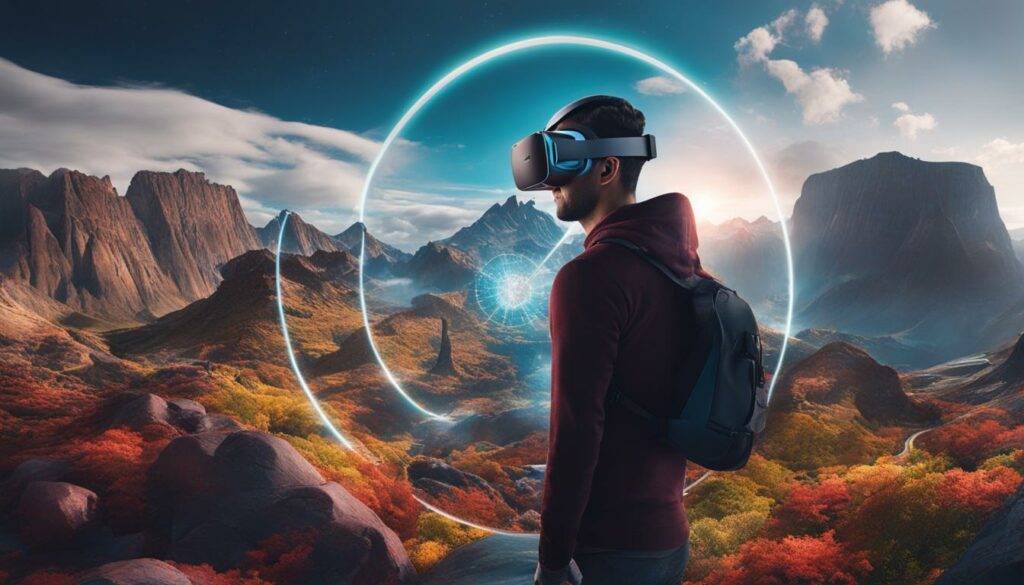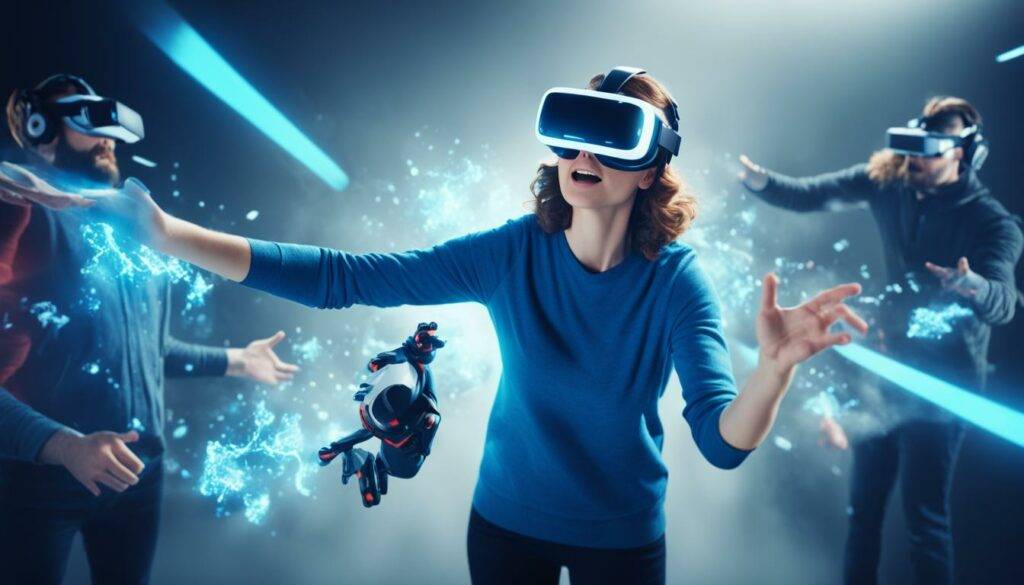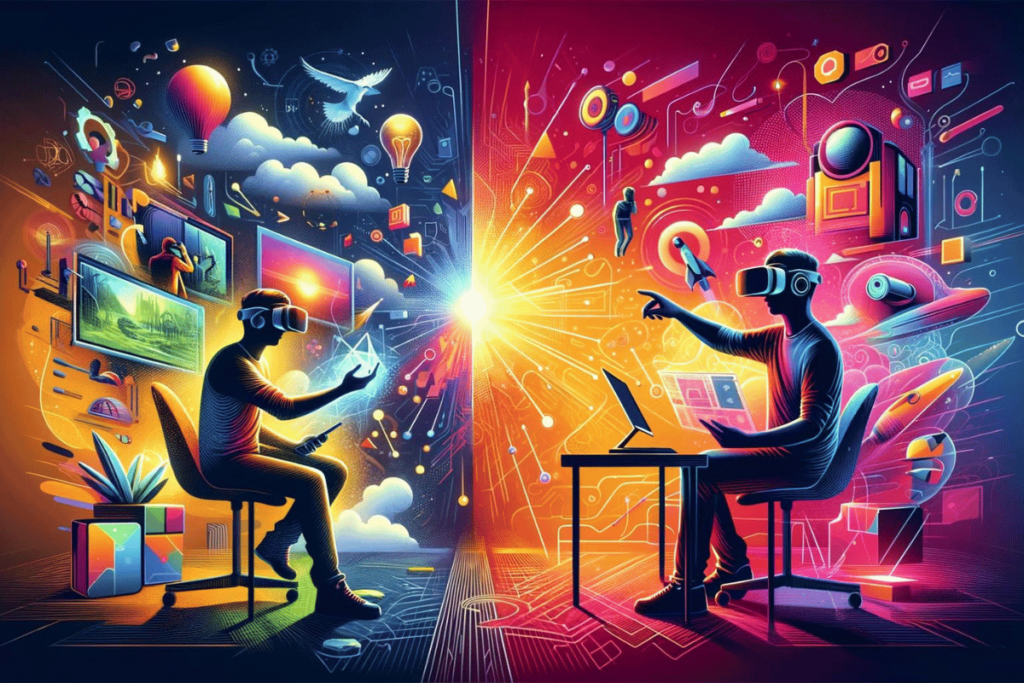Overlays digital content onto the real world. Welcome to our comprehensive guide on Augmented Reality (AR) and Virtual Reality (VR) technologies. In this article, we will provide you with an in-depth understanding of AR vs VR, their unique characteristics, and their respective use cases.
AR and VR have gained significant prominence in recent years, revolutionizing the way we interact with digital information and immersive experiences. While they both offer captivating and exciting possibilities, it’s crucial to recognize their key differences and the industries that benefit from them.
Are you ready to explore the world of AR and VR? Let’s dive in!
Key Takeaways:
- AR and VR technologies provide immersive experiences and transform industries.
- AR overlays digital information onto the real world, enhancing interactions.
- VR creates simulated environments, allowing users to explore new realms.
- AR finds applications in gaming, healthcare, retail, and education.
- VR is used in gaming, training simulations, entertainment, and architecture.
Understanding Augmented Reality (AR)
Welcome to the fascinating world of Augmented Reality (AR), where digital information seamlessly blends with the real world, enhancing our everyday experiences. AR technology overlays computer-generated elements onto our physical surroundings, enabling us to perceive the digital and physical realms in harmony.
AR has revolutionized various industries, from entertainment and gaming to education and healthcare, offering endless possibilities for innovative applications. Let’s explore some of the different types of Augmented Reality products and their diverse range of applications.
Types of Augmented Reality Products:
Augmented Reality products come in various forms, each designed to cater to specific needs and use cases. Here are some of the most common types:
- Headsets and Glasses: AR headsets and glasses, such as Microsoft HoloLens and Google Glass, provide users with an immersive AR experience by overlaying digital content directly on their field of view. These devices offer hands-free interactions and are widely used in industries like engineering, architecture, and manufacturing.
- Smartphones and Tablets: AR applications on smartphones and tablets leverage the camera and display capabilities of these devices to provide AR experiences. Users can access AR features through apps, allowing them to interact with virtual objects in their physical environment.
- Smart Glasses: Smart glasses, like Snapchat Spectacles and Vuzix Blade, combine traditional eyewear with AR technology. These glasses display digital content on transparent lenses, enabling users to view and interact with virtual objects while maintaining awareness of their surroundings.
- AR Cameras and Projectors: AR cameras and projectors capture real-world scenes and project digital content onto them, creating an augmented environment. This technology is commonly used in interactive advertising, art installations, and live events.
Applications of Augmented Reality:
The applications of Augmented Reality are vast and continually expanding. Let’s explore some popular use cases across different industries:
- Retail: AR allows customers to visualize products in their own spaces before making a purchase, enhancing the online shopping experience. IKEA’s AR app, for example, enables customers to digitally place furniture in their homes to see how it fits.
- Healthcare: AR is transforming healthcare by providing surgeons with real-time, 3D visualizations during complex procedures. It also aids in medical training, patient education, and rehabilitation therapies.
- Gaming and Entertainment: AR adds a new dimension to gaming and entertainment experiences by merging virtual elements with the real world. Pokémon Go, a popular AR game, allows players to capture virtual creatures in their physical surroundings.
- Education: AR enhances learning experiences by bringing educational content to life. Students can explore historical sites, dissect virtual organisms, and visualize complex concepts in a more immersive and engaging manner.
These are just a few examples of how Augmented Reality products are revolutionizing various industries. The potential for AR applications is vast, and as technology continues to advance, we can expect even more remarkable use cases in the future.
Visualizing the possibilities of Augmented Reality products is essential in understanding their impact on industries and everyday life. The image above represents the seamless integration of digital information onto our physical environment, showcasing the transformative potential of AR technology.
Exploring Virtual Reality (VR)
In this section, we will dive into the fascinating world of Virtual Reality (VR) and discover how it transports users into immersive simulated environments. VR technology has revolutionized various industries, providing incredible experiences and unlocking new possibilities.
Virtual Reality products
VR Products come in different forms, each designed to deliver unique and captivating experiences. Let’s explore some of the most popular types:
- VR Headsets: These head-mounted displays (HMDs) allow users to enter virtual worlds by completely blocking out the real environment. They often feature high-resolution screens, built-in sensors, and advanced tracking systems to enhance immersion.
- VR Controllers: These handheld devices enable users to interact with the virtual world, providing haptic feedback and precise motion tracking. VR controllers enhance the overall experience by allowing users to manipulate objects and navigate virtual environments.
- VR Treadmills and Motion Platforms: These devices enable users to physically walk, run, or move in the VR environment, increasing the sense of presence and realism. They provide a more immersive and physically engaging experience.
- VR Accessories: In addition to headsets and controllers, there is a wide range of accessories available that enhance the VR experience. These include VR gloves for hand tracking, full-body suits for realistic interactions, and even haptic feedback vests for a truly sensory experience.
VR Product Uses
The uses of Virtual Reality products are vast and encompass various industries. Here are some prominent examples:
- Gaming: Virtual Reality has revolutionized the gaming industry, allowing players to step into the game and interact with virtual worlds like never before. The immersive nature of VR makes gaming experiences more thrilling and engaging.
- Training and Simulations: VR finds applications in training scenarios where real-life practice could be impractical, expensive, or risky. Industries such as aviation, medicine, engineering, and military utilize VR simulations to train professionals in realistic environments.
- Entertainment and Media: VR enables users to immerse themselves in virtual concerts, movies, and other entertaining experiences. It provides a new dimension to storytelling, making it more interactive and engaging.
- Architecture and Design: Architects and designers use VR to visualize and explore structures and designs before they are built. This allows for better spatial understanding and the ability to make real-time changes and adjustments.
Virtual Reality offers a whole new level of immersion and interactivity, catering to a wide range of interests and industries. Let’s take a closer look at the various types of VR products and their uses with the help of this comprehensive table:
Virtual Reality Product |
Description |
Use Cases |
|---|---|---|
| VR Headsets | Head-mounted displays that shut out the real world and create a virtual environment. | Gaming, training simulations, virtual tourism, entertainment. |
| VR Controllers | Handheld devices that enable users to interact with virtual objects and environments. | Gaming, design, training simulations, virtual collaboration. |
| VR Treadmills and Motion Platforms | Devices that enable users to physically move and explore virtual environments. | Gaming, physical training, virtual tourism, architecture. |
| VR Accessories | Additional devices that enhance the VR experience, such as haptic feedback gloves and vests. | Gaming, entertainment, simulations, medical training. |
Through Virtual Reality products, users can embark on incredible virtual adventures, gain new perspectives, and push the boundaries of what is possible. The immersive nature of VR opens up endless opportunities for entertainment, training, and exploration.

Key Differences Between AR and VR Technologies
Augmented Reality (AR) and Virtual Reality (VR) are two distinct technologies that offer immersive experiences to users. While both AR and VR involve the integration of digital content with real-world environments, there are significant differences between them.
Immersive Experiences
AR enhances the real world by overlaying digital information, such as images, videos, and 3D models, onto the user’s view. Users can still see and interact with the physical environment while experiencing AR content. On the other hand, VR completely immerses users in a simulated environment, blocking their view of the real world.
Interactivity
AR technology allows users to interact with digital content in real-time, typically through gestures, voice commands, or touch interactions. Users can manipulate and modify AR objects within their physical surroundings. In contrast, VR experiences are more controlled and predefined. Users typically navigate through virtual environments using handheld controllers or motion-tracking sensors.
Use Cases
The use cases for AR and VR differ based on their unique capabilities. AR has found applications in various industries, including education, healthcare, retail, marketing, and gaming. It enables users to visualize products in their own space, enhances learning experiences, and provides medical practitioners with real-time information and guidance.
VR, on the other hand, is primarily used in gaming and entertainment, offering users immersive and interactive experiences in virtual worlds. It is also utilized for training simulations in industries such as aviation, construction, and military.
“AR and VR technologies offer distinct experiences to users, catering to different needs and use cases. While AR blends the real world with digital overlays, VR creates fully immersive virtual environments.”
Here is a table summarizing the key differences between AR and VR technologies:
| Aspect | Augmented Reality (AR) | Virtual Reality (VR) |
|---|---|---|
| Content Overlay | Overlays digital content onto the real world | Completely immerses users in a virtual world |
| User Interaction | Users can interact with both real and digital content simultaneously | Users interact with virtual environments |
| Primary Applications | Applications in education, healthcare, retail, marketing, and more | Primarily used in gaming and entertainment |
As you can see, AR and VR offer distinct experiences and cater to different use cases. Understanding their differences is crucial when considering the implementation of these technologies in various industries.
Use Cases for Augmented Reality (AR)
Augmented Reality (AR) technology has made significant strides in recent years, revolutionizing various industries with its immersive and interactive capabilities. Let’s explore some key use cases that highlight the transformative power of AR in different sectors:
Gaming
AR has revolutionized the gaming industry by merging digital content with the real world, creating innovative and engaging gaming experiences. Popular games like Pokemon Go and Harry Potter: Wizards Unite have captivated millions of players, allowing them to interact with virtual elements in their surroundings.
Healthcare
AR is transforming the healthcare industry, offering enhanced visualization and training tools for medical professionals. Surgeons can utilize AR headsets to overlay 3D models of organs during surgeries, improving precision and reducing risks. Additionally, AR technology is being employed to create interactive patient education materials and assist in rehabilitation programs.
Retail
The retail sector has embraced AR to enhance the shopping experience for customers. AR-powered applications allow consumers to virtually try on clothing or accessories, visualize furniture in their homes, and explore interactive product catalogs. This immersive approach drives customer engagement and enables more informed purchasing decisions.
Education
AR has immense potential in education, offering interactive and experiential learning opportunities. Students can engage with virtual models of complex concepts, explore historical sites through AR tours, and participate in immersive language learning experiences. AR enriches traditional teaching methods and encourages active student participation.
Manufacturing
AR is reshaping the manufacturing industry by streamlining operations and improving efficiency. With AR-powered wearable devices, workers can receive real-time instructions and visual cues, reducing errors in complex assembly processes. This technology also enables remote assistance, allowing experts to guide technicians in real-time, leading to faster troubleshooting and maintenance.
Architecture and Design
AR is revolutionizing the architectural and design processes by enabling virtual modeling and visualization. Architects and designers can superimpose virtual structures onto real-world environments, allowing clients to experience the proposed designs before construction begins. This enhances collaboration, reduces costs, and minimizes design errors.
These are just a few examples of how Augmented Reality (AR) technology is transforming various industries. The versatility and potential of AR use cases continue to expand, contributing to a more immersive and interconnected future.

Applications of Virtual Reality (VR)
The world of Virtual Reality (VR) technology holds immense potential across various industries and sectors. Let’s explore the diverse range of applications where VR is making a significant impact:
Gaming
Virtual Reality has revolutionized the gaming industry, immersing players in a fully interactive virtual world. With VR headsets and controllers, gamers can experience realistic gameplay and become part of the action.
Training Simulations
VR is being extensively utilized for training purposes in various fields, including aviation, healthcare, and military. By creating realistic simulations, trainees can practice complex tasks in a safe and controlled environment, enhancing their skills and knowledge.
Entertainment and Media
Virtual Reality has transformed the entertainment and media landscape by offering immersive experiences. From virtual concerts and 360-degree videos to VR movies and interactive storytelling, users can engage with content like never before.
Architecture and Design
Architects and designers are leveraging VR technology to visualize and present their projects in a realistic and immersive way. VR allows clients and stakeholders to explore virtual models, walk through buildings, and make design decisions based on a compelling interactive experience.
Healthcare and Therapy
Virtual Reality is finding promising applications in healthcare, including pain management, rehabilitation, and mental health therapy. VR experiences help patients distract themselves from discomfort, simulate real-life scenarios for rehabilitation, and provide therapeutic environments for psychological treatment.
Education and Training
VR is revolutionizing the way we learn and train. From virtual field trips and historical reconstructions to interactive biology lessons and language immersion, VR adds an extra layer of engagement and interactivity, making learning more captivating and effective.
With its boundless possibilities, Virtual Reality continues to push the boundaries of innovation. The next section will examine the advantages and limitations of both Augmented Reality (AR) and Virtual Reality (VR) technologies.

Advantages and Limitations of AR and VR
Augmented Reality (AR) and Virtual Reality (VR) technologies offer unique experiences and benefits, but they also come with their own set of advantages and limitations. In this section, we will explore these factors and provide a comprehensive analysis of what AR and VR offer.
Advantages of AR and VR Technologies
1. Enhanced User Experience: Both AR and VR technologies provide immersive and interactive experiences, allowing users to engage with digital content in a more intuitive and engaging way.
2. Expanded Possibilities: AR and VR open up new possibilities across various industries, including gaming, education, healthcare, retail, and more. These technologies offer innovative solutions that enhance training, visualization, and customer engagement.
3. Real-World Applications: AR enables users to overlay digital information onto the real world, enhancing situational awareness and transforming industries like real estate, architecture, and interior design. VR allows users to explore virtual environments, providing opportunities for simulations, therapy treatments, and virtual tourism.
4. Collaboration and Communication: AR and VR technologies enable remote collaboration and communication, bridging the gap between global teams and offering real-time interactions regardless of physical location.
| Advantages of AR | Advantages of VR |
|---|---|
| Improves real-world visualization | Enhances immersion and presence |
| Offers real-time data overlay | Provides realistic simulations |
| Enhances user engagement | Enables virtual travel and exploration |
Limitations of AR and VR Technologies
1. Cost: Implementing AR and VR technologies can be costly, especially for businesses looking to integrate these technologies into their operations. The cost of hardware, software development, and maintenance can pose financial constraints.
2. Accessibility: Not everyone has access to AR and VR devices or experiences. Limited availability, lack of affordability, or unfamiliarity with technology can hinder widespread adoption.
3. User Comfort: Prolonged use of AR and VR devices can lead to discomfort, including motion sickness and eye strain. Design considerations must be taken into account to optimize user comfort.
4. Technical Limitations: AR and VR technologies are continuously evolving, and current hardware and software limitations may restrict their full potential. Advances in processing power, visual fidelity, and user interfaces are necessary for optimal experiences.
| Limitations of AR | Limitations of VR |
|---|---|
| Dependent on real-world conditions | Potential for motion sickness |
| Reliance on camera and tracking accuracies | Heavy and cumbersome equipment |
| Visual overlays can obstruct real-world view | Isolation from the physical environment |
While AR and VR technologies offer exciting possibilities, it is essential to consider their advantages and limitations when deciding on their implementation. Careful consideration of these factors ensures optimal utilization and successful integration into various domains.
Future Trends and Developments in AR and VR
The world of Augmented Reality (AR) and Virtual Reality (VR) is constantly evolving, and there are several exciting future trends and developments on the horizon. This tech will become essential as we progress into the future. These advancements have the potential to revolutionize various industries, from gaming and entertainment to healthcare and education.
1. Enhanced Immersive Experiences
One of the key areas of focus in AR and VR technologies is enhancing the immersive experience for users. The future holds groundbreaking advancements in graphics, sound, and haptic feedback, which will further blur the line between the digital and physical worlds. Users can expect more realistic visuals, improved audio quality, and even tactile sensations that replicate the sense of touch.
2. Increased Adoption in Industrial Applications
AR and VR technologies are already making waves in industries such as architecture, manufacturing, and training simulations. In the future, we can anticipate a wider adoption of these technologies in industrial applications. Companies will leverage AR and VR to streamline workflows, improve employee training, and enhance remote collaboration. For example, architects can use AR to visualize building designs on-site, while manufacturers can utilize VR to simulate production processes.
3. Integration with Artificial Intelligence
The integration of AR and VR with Artificial Intelligence (AI) will be another significant development in the future. AI algorithms can enhance the capabilities of AR and VR technologies by analyzing user data, providing personalized experiences, and enabling more natural interactions. For instance, AI-powered voice recognition can enable users to control AR and VR devices through voice commands, making the experience more intuitive and seamless.
4. Advancements in Wearable Devices
Wearable devices, such as AR glasses and VR headsets, will continue to evolve and become more advanced in the coming years. We can expect lighter, more comfortable devices with improved display resolutions and wider fields of view. These advancements will make AR and VR more accessible and user-friendly, opening up new possibilities for immersive experiences in various domains.
5. Expansion into Healthcare and Therapy
AR and VR technologies have already shown great potential in the healthcare industry, aiding in medical training, surgical planning, and patient rehabilitation. In the future, we can expect further expansion into healthcare and therapy applications. VR simulations can be used to treat phobias, PTSD, and anxiety disorders, while AR can assist surgeons during complex procedures. These technologies have the power to revolutionize healthcare and improve patient outcomes.
6. Growing AR and VR App Ecosystem
The future will see a rapid growth in the AR and VR app ecosystem. Developers will create an array of innovative applications, ranging from immersive gaming experiences to practical tools for education and productivity. As the demand for AR and VR content increases, we can anticipate a flourishing marketplace for apps, stimulating further advancements and pushing the boundaries of what is possible.
| Future Trends and Developments in AR and VR | Description |
|---|---|
| Enhanced Immersive Experiences | Advancements in graphics, sound, and haptic feedback to create more realistic and immersive experiences. |
| Increased Adoption in Industrial Applications | AR and VR technologies being used in architecture, manufacturing, and employee training. |
| Integration with Artificial Intelligence | Combining AR and VR with AI algorithms for personalized experiences and natural interactions. |
| Advancements in Wearable Devices | Lighter, more comfortable AR glasses and VR headsets with improved display resolutions and fields of view. |
| Expansion into Healthcare and Therapy | AR and VR applications in medical training, surgical planning, patient rehabilitation, and mental health therapy. |
| Growing AR and VR App Ecosystem | A flourishing marketplace for innovative AR and VR applications across gaming, education, and productivity. |
With these future trends and developments, Augmented Reality (AR) and Virtual Reality (VR) technologies are poised to reshape the way we interact with the digital world and revolutionize numerous industries.
Overlapping Technologies: Mixed Reality (MR)
In the ever-evolving landscape of immersive technologies, one concept that stands out is Mixed Reality (MR). Combining elements of both Augmented Reality (AR) and Virtual Reality (VR), MR represents a harmonious fusion of these two revolutionary technologies.
Introduction to Mixed Reality
Mixed Reality (MR) seamlessly blends virtual and real-world environments, enabling users to interact with both physical and digital elements simultaneously. This immersive experience offers unique capabilities, providing a powerful tool for various industries.
With MR, users can manipulate and augment their surroundings, blurring the line between the virtual and real world. The technology utilizes precise tracking, advanced sensors, and spatial mapping, enabling realistic and interactive experiences.
Mixed Reality in Architecture and Design
One popular application of Mixed Reality is in the field of architecture and design. Architects can now create virtual models of buildings and visualize them in real-world settings. This allows for better planning, improved collaboration, and enhanced decision-making.
Mixed Reality in Healthcare
Even the healthcare industry has found uses for this type of technology. Surgeons can employ MR technology to overlay vital information during surgeries, providing real-time guidance and enhancing precision. This breakthrough has the potential to revolutionize medical procedures and improve patient outcomes.
Mixed Reality in Education
Another compelling use case for Mixed Reality is in the realm of education. Through immersive simulations, students can explore historical events, scientific concepts, and complex machinery in a realistic and engaging manner. This experiential learning approach can greatly enhance comprehension and retention.
Mixed Reality in Retail
Mixed Reality has the potential to transform the way we shop. By integrating virtual elements into physical retail spaces, retailers can offer a personalized and interactive shopping experience. Customers can try on virtual clothing, visualize furniture in their homes, and receive personalized recommendations, all within the comfort of a physical store.
Mixed Reality Applications Across Industries
With its ability to seamlessly merge the digital and physical worlds, Mixed Reality holds immense promise for various industries, including gaming, engineering, entertainment, and more. As the technology continues to evolve, we can expect even more innovative applications and groundbreaking experiences.
| Mixed Reality (MR) Use Cases | Industries |
|---|---|
| Architectural visualization | Architecture and design |
| Surgical guidance | Healthcare |
| Immersive education | Education |
| Virtual try-on | Retail |
| Virtual prototyping | Engineering |
| Virtual entertainment | Gaming and entertainment |
Conclusion
In conclusion, the world of immersive technologies offers two distinct but equally fascinating experiences: Augmented Reality (AR) and Virtual Reality (VR). Both AR and VR technologies have transformed various industries, allowing for new and innovative use cases.
Augmented Reality (AR) products enhance the real world by overlaying digital information onto the physical environment. They have found applications in gaming, healthcare, retail, and education, among others. AR allows users to interact with virtual objects while maintaining a connection to the real world.
On the other hand, Virtual Reality (VR) products create fully immersive simulated environments, transporting users to virtual worlds. VR has revolutionized gaming, training simulations, entertainment, and even architecture. With VR, users can experience new realities and engage with digital content in unprecedented ways.
While Augmented Reality (AR) and Virtual Reality (VR) have their unique characteristics and applications, they both contribute to the advancement of AR and VR technologies. As these technologies continue to evolve, we can expect exciting developments in the future, including advancements in hardware, software, and content creation tools. With their immense potential, AR and VR are poised to reshape industries and revolutionize user experiences.
FAQ
What is the difference between Augmented Reality (AR) and Virtual Reality (VR) technologies?
Augmented Reality (AR) overlays digital information onto the real world, enhancing the user’s environment. Virtual Reality (VR) immerses the user in a simulated environment, typically through the use of a headset.
What are some examples of Augmented Reality products?
Examples of Augmented Reality products include mobile apps that overlay digital information onto real-world objects, smart glasses or headsets that enhance the user’s vision, and interactive digital displays.
What are some examples of Virtual Reality products?
Virtual Reality products include VR headsets that transport users to virtual environments, VR gaming consoles, and VR simulators used for training purposes.
How do Augmented Reality (AR) and Virtual Reality (VR) differ in terms of functionality?
AR enhances the real world by overlaying digital elements, such as images, videos, or animations. VR, on the other hand, replaces the real world with a simulated environment, creating a fully immersive experience.
What are some use cases for Augmented Reality (AR) technology?
Augmented Reality finds applications in a variety of industries, including gaming, healthcare, retail, education, and architecture. It can be used for interactive gaming experiences, virtual try-on for retail products, educational simulations, and visualizing architectural designs.
How is Virtual Reality (VR) technology used in different industries?
Virtual Reality is utilized in gaming for immersive experiences, in training simulations for various industries, in entertainment for virtual experiences, in architecture for interactive walkthroughs, and in healthcare for pain management and therapy.
What are the advantages and limitations of Augmented Reality (AR) and Virtual Reality (VR) technologies?
Advantages of AR include enhancing real-world experiences, increasing engagement, and offering practical applications in various industries. Limitations include reliance on hardware and potential user discomfort. VR advantages include total immersion, realistic experiences, and training simulations. Limitations include the need for specialized equipment and a potential disconnect from the real world.
What are some future trends and developments in Augmented Reality (AR) and Virtual Reality (VR) technologies?
Future trends in AR and VR include advancements in hardware technology, more seamless integration with everyday devices, improved user interfaces, expanded use cases in industries such as education, healthcare, and manufacturing, and the rise of social VR experiences.
What is Mixed Reality (MR) technology?
Mixed Reality (MR) is a combination of Augmented Reality (AR) and Virtual Reality (VR), enabling the user to interact with both digital and physical objects in real time. This technology blends the real and virtual worlds, creating a seamless and interactive experience.






